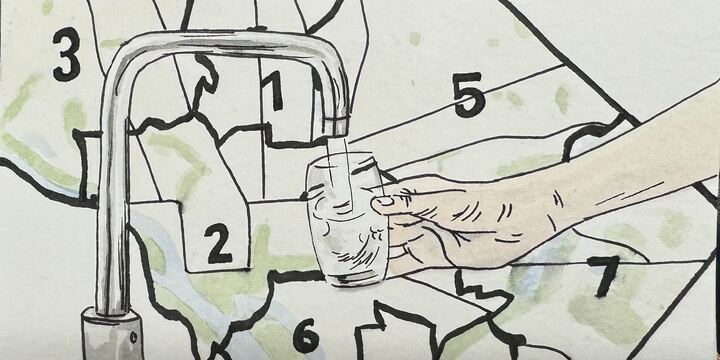
ILLUSTRATION BY: LAUREN BECK/THE HOYA | The Washington, D.C., Lead Pipe Replacement Assistance Program (LPRAP) is working to remove lead pipes on residential properties. Disproportionate exposure to lead and other environmental pollutants in communities of color underscores the continuing impact of environmental injustices.
Georgetown University students living off-campus in the Burleith neighborhood may soon benefit from an opportunity to replace lead pipes on residential properties as a Washington, D.C. government program begins its work to remove lead pipes in the neighborhood.
The Washington, D.C., Lead Pipe Replacement Assistance Program (LPRAP) provides free or discounted removal of lead pipes on private land to eligible residents with funding from the Bipartisan Infrastructure Law. These efforts are part of President Joe Biden’s Lead Pipe and Paint Action Plan, a commitment to replace the lead pipes in all of the nation’s drinking water systems within 10 years, which targets lead found in pipes, faucets and building interiors, intending to enlist plumbers in D.C. and across the United States to replace the country’s lead pipes and service lines.
Plumbing materials containing lead can contaminate drinking water through a chemical reaction called corrosion in which the metal dissolves or wears away from pipes and fixtures. The short-term symptoms of lead exposure are mild, including headaches, stomach pain, joint pain, fatigue and irritability. However, the long-term dangers of lead exposure range from high blood pressure to irreversible brain damage — a risk particularly high for young children.
The D.C. Water and Sewer Authority created an interactive map that tracks the presence of lead on private and public property in D.C. According to William Elledge, director of engineering and technical services at D.C. Water, current data estimates that 7,000 of the roughly 42,000 lead service lines in D.C. have been replaced in recent years.
Elledge said the pipe replacement process moves slowly due to its invasive nature.
“It’s a disruption to every homeowner,” Elledge told The Hoya. “The improvements that the Biden administration and the EPA pushed forward and finalized a couple months back require that we enter people’s homes.”
Caroline Samoluk (CAS ’25), a Burleith neighborhood resident, recently discovered that her residence had lead pipes and would be eligible for free pipe replacement.
“The lead pipes situation makes me really nervous, especially because I am finding out about this now after having lived here since August,” Samoluk told The Hoya. “Previously, I had no idea that there was any danger and I only found out when my roommate told me we were eligible after doing some research.”
Samoluk said she is dissatisfied with the apparent lack of urgency to remove the lead pipes and the lack of information about what tenants can do to speed removal.
“I have not felt a great sense of urgency from the district and landlords to get the pipes replaced and I wish I did,” Samoluk said. “I would feel better if there was more aggressive advertising from the district and more communication with landlords.”
Efforts to decrease lead exposure in the District are further complicated by the impacts of environmental injustices. Tim Bartley, professor at the Georgetown University Earth Commons, said the impact of systemic environmental injustice manifests as the disproportionate exposure to environmental hazards.
“I think it’s really clear that ordinary citizens and particularly people of color, who have faced severe hazards, have been really instrumental in drawing attention to environmental injustice and the unequal burden of various kinds of environmental hazards that are faced by low-income people, and especially low-income people of color,” Bartley said.
In D.C., Black families are at greater risk of lead exposure than other socioeconomic groups. Nationally, there is a strong negative association between risk of lead exposure and income. These imbalances are likely due in part to the cost associated with removing and replacing lead pipes. By reducing the cost barrier, LPRAP could help address existing environmental injustices.
Bartley also said there is uncertainty around the continued involvement of the federal government in environmental justice initiatives, like LPRAP, during president-elect Donald Trump’s second term.
“I think what everyone in the environmental justice world is thinking about now is what happens under a second Trump administration,” Bartley told The Hoya. “My sense is that there are a whole bunch of people working on environmental justice in D.C. and in various parts of the federal government who are moving to other places or looking for new jobs.”
In D.C., environmental injustices extend beyond lead exposure. Air and water pollution disproportionately impact majority-Black communities in D.C. living in Wards 1 and 7 along the Anacostia River. Increased levels of exposure have been linked to release of toxic chemicals by large companies and contribute to severe negative health outcomes, including higher rates of asthma.
Patterns of environmental injustice repeat across the country. The Biden administration’s plan to replace all lead pipes in the nation’s drinking water systems could be of particular importance to communities whose health has been historically overlooked.
Bartley said past environmental justice movements have been rooted in local community organizing and that future movements and advocacy are possible even without government support.
“People have been quite remarkable in compiling their own evidence of the hazards in their communities,” Bartley said. “It takes a lot of work on their part, but they can become activists and gather the evidence to start to put the pieces together on their own.”